Population assignment: Accessibility to Healthcare in Australia
Question
Task Description:
Assessment task three requires the preparation of a full project proposal that should not exceed
3000 words excluding the cover page and reference list.
Students need to address the following:
- Refined Problem Statement, Aim, Objectives and Scope- students need to provide a detailed statement of the problem you would like to investigate as well as aim and objectives of the project within the scope of the study.
- Research Project Justification and Potential Outputs - students need to explain why your chosen project is important both theoretically and practically? What are the potential outputs and outcomes of your research?
- The Conceptual Framework - students need to provide an analysis of the literature relevant to the research project that leads to the development of a conceptual framework for conducting the research.
- Methodology - based on the conceptual framework, research aim and research objectives, students need to provide a detailed description of the data collection methods, tools and data sources that will be used to analyse the data.
- Research Project Organisation, Budget and Schedule - students need to present all components of the research report by writing the names of the chapters/sections and briefly discussing what will be written in each of those chapters/sections followed by a brief description of the budget and project schedule.
This is an individual research task. Students are required to demonstrate their understanding of the relevant body of work in a real-life business research context. We expect students to read and reflect on at least twenty recent refereed journal articles on your topic, supported by any other evidence or information that can help refine the problem of your research, formulate a conceptual framework and develop the methods for data collection and analyses.
Answer
Introduction
Refined Problem Statement, Aim, Objectives and Scope
Problem statement
As per the study of Farrer et al., (2018) considered while developing this population assignment;it has been found that Australian heath care system is one of the developed health care systems across the globe. After the onset of the globalisation process, the Australian government took the initiative to participate in the process and reap the maximum benefits out of it. Globalisation features in Australia can be observed from the year of 1985. According to the study of Hopper, Lassou&Soobaroyen, (2017), it has been found in the context of population assignment that Australia is perceived to be the most successful country that developed itself after the globalisation process. At the global scale, Australia is one of the highly industrialised countries, and this industrialisation's effects can also be observed in the Australian health care sector. Health care system of Australia involves implementation all the latest disruptive technologies in it, and this implementation indicates how developed is the system is, however, several research studies have shown that despite having highly advanced health care sector Australia has failed to incorporate equity features within the health care sector.
According to the study of Senn et al.,(2019),it is observed that Australian federal government has made the public access over the health care system for free and at some level at very lower costs through Medicare scheme (funded by tax). Despite this free health care, it is found by several types of research on population assignment that 7 million rural populations of the country lags in obtaining the health care services and this lack of medical facilities have resulted in shorter lives of the rural population. In the 88.9 per cent urban population, this accessibility issue is less; however, in the rural population, health care services accessibility is very low. Government although introduced several schemes to uplift the health of the people of the country but yet this kind of inequality prevails in the country, and this question the inclination of the government system towards the urban population.
Research Aim and Objectives
This study provided within this population assignment aims to explore the accessibility of health care services by the Australian population. The main objectives to be explored by this population assignmentare:
- To examine the health care systems of Australia
- To evaluate the extent of the health care system within the Australian population
- To recommend suggestions for fostering equality in accessible extents of health care services for the Australian population
Research Scope
Considering the results of different research studies which is uneven access of heath cares services for the Australian population, this population assignmentwill investigate the health care access aspects of Australia. The investigation is necessary to explore whether the results obtained by other studies are feasible or not. Further, this investigation will help to have an overview of the health care access by the Australian population. Australia is one of the highly developed countries where GDP per capita is $50,023, and this is quite a large amount, despite this high per capita of the country, the existence of inequality in health care services is not desirable (Altman,2018). Hence an investigation of this issue by this study will shed light on how much access is the health care system by the Australian population.
Research project justification and potential outputs
Significance of the study
The research study build on this population assignment upon the health care access for the population in Australia is a significant one because this will help to gather information about the health care services extent in Australia. Thus, by carrying out this reach, an insight can be created about the health care system access and its impact on the Australian population. Health care sector of Australia is one of the highly developed industry in the present times, and this is evident from the decreasing death rate within the country in 1990s death rate was 7.07 while in 20th century particularly in 2018, the death rate reduced to 6.622 (Cobiac et al., 2017),and this reduction is due to the development of the health care sector of the country. This current population assignmentthus will show that despite decreasing death rate prevailing in the country, why health care services access by rural population is low, hence practically this study will show light upon the issueswhy a developed country like Australia have more economical health care services access by the rural population. Theoretically, this study is a significant one because it will show how development concepts of the economy are applicable in the present population assignment.
Potential Outputs and outcomes of this study
The results obtained by this study will pave the path for the future researches on the same topic. Results expected from this study on population assignmentare:
- This study will shed light on the health care system of Australia
- The study will help to obtain information about the role of the federal government in setting policies for Australian population regarding health care facilities utilisation
- One of the primary outcomes expected from this study is to gather information regarding the urban population's access over health care services and the rural population’s access over the heath cafes services of Australia
- The study is also expected to provide detail about why inequality prevail within Australia regarding heath case services access
- One of the outcomes expected from this research study is how lack of heath care services access is resulting in severe issues
Conceptual Framework- Literature review
Australian heath care system
Australia over the decades has positioned itself as one of the powerful countries across the globe. Macroeconomic indicators of the country show that they are stable ones. According to the study of it can be found that Australia over the past years have never encountered fall in its GDP, rather Australian GDP every year shows positive number and growth(Pandya&Sisombat, 2017). Hence, this economic growth considered in this section of population assignment indicates that all the sectors of the economy are also performing well within the country. As per World Health Organization’s report, Australia has achieved high life expectancy within the country along with the well-established universal health care system for the whole population of the country. Apart from this, WHO also identified that Australia has strong regulatory framework in heath care which enabled the country to occupy global leadership position in public health.
According to the study ofJin et al., (2019), it can be found that Australia has a health care system that is regionally administered one, in Australia the public health insurance program is subsidised by government. Enrolment for availing heath care services is automatic for the citizens. As per the research on population assignment, in Australia it can be seen that half of the population has private insurance. In 1975 country’s universal public health insurance program was introduced, further in 1984 the program was revamped by considering free care for Australian citizens, residents with permanent visas, citizens of New Zealand. As per the study of Rasanathan et al., (2017), it has been assessed that three levels of government in Australia collectively work for public heath care and these governmental bodies performs different roles. Federal government pay funding’s and support, state owns and manages the delivery of the services, apart from this state also contribute its own funding to public health and local government play vital role in delivery of community healthcare programs which are immunisations. Apart from these three supreme bodies in heath acre other federal agencies are also involved in the sector.
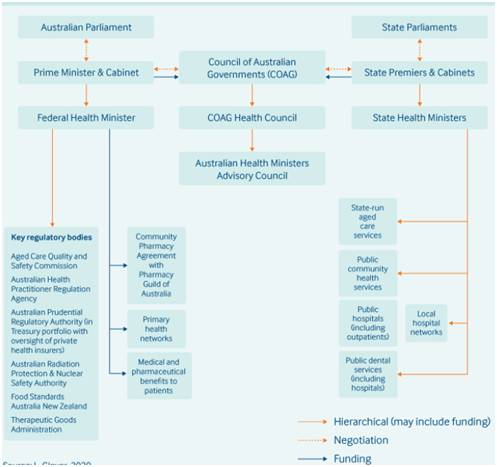
Diagram: Organization of health system in Australia
(Source:Tse et al., 2016)
Increasing disparities in health care access in Australia
Access to quality health services in Australia have been identified as issue for the population of the country. The issue regarding access evolved because only minority of the people receives health care services. The access issue exacerbated mainly for the people living in the rural areas. According to the study of Tyna et al., (2020), it has been found herein population assignment that in rural areas of Australia people suffer from lack of health care’s services and this access over heath care of these people over the course of time even worsened because these people fear of stigma and faces financial barriers and this has resulted in less usage of the GPs in these areas.
The population assignmentexamines the study of Steffens, Jamieson &Kapellas, (2016) that disparity in term of heath care services in Australia is prominent between Aboriginal and Torres Strait Islander population. Hence racists attitudes can be observed within the Australian population; in order to tackle this discrimination government even intervened by introducing some of the anti-racist policies. Thus, this racism is seen to impact the health of the indigenous groups and their wellbeing. In 2008, Council of Australian Government introduced target of reducing the gap in life expectancy by 2031. This governmental target however was supported by non-governmental bodies. This target however, observed to achieve progress because current gap is 9.5 years for females and 10.6 years for males. In Australia one of the major challenges faced is in rural areas the heath cares services coverage is very low. As opined by the study ofJones et al., (2016) in regards to the case scenario of population assignment, in rural areas particularly in the outer regions and remote areas number of Government practitioners is very low in number, further so specialists are located in nearby areas.
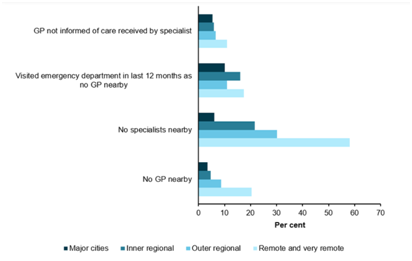
Graph: Patients experiences across Australia (Source: Worrall-Carter et al., 2016)
Heath workforce in Australia is estimated by considering number of full time professional by estimated residents in that area. In Remote and very remote places of the country heath workforce shows shortages, in these areas the demand of heath professional is very high and despite this high demand supply is low. As per the study of Kwan et al., (2017),it can be seen that the rate of specialists and GP numbers substantially decreased in remote and very remote areas of Australia because here remoteness has increased over the years and this decrease is due to shift of a chunk of the population in the urban cities of the country. Thus, the information provided in the population assignment signifies that from number of specialists in major cities of the country is 143 per 100,000 populations while in remote areas it is 22 per 100,000 population. The study by Mnatzaganian et al., (2020), on the Australian heath care access have shown that in 2017-18 people living in remote areas were hospitalised more that people living in major cities and this number is 1.3 times. Distribution of private hospitals is less in number in remote areas; the same is true for government hospitals. In major cities the rehabilitation care is high than remote areas, this is due to fact in major cities preventive measures are considered first before the curative measures.
What are the steps undertaken by government to reduce disparities in health care access discussed in the population assignment?
In order to improve healthcare services access, Australian government introduced many new programs and delivery models since the first National Rural Heath Strategy of 1994. As per the study of Trankle&Reath, (2019), it has been found that inadequate evaluation of the government initiatives in Australia have resulted in failure of the initiatives generated by government and for this reason the condition of the access of the heath cares services even worsened in the areas which indicated a sharp inequality in the heath care access within the country for the population. Federal government to tackle the growing inequality aspects in term of heath cares services have undertaken initiatives to increase the number of GP, nurses and midwives’ numbers in the remote and very remote areas. This initiative however, is undertaken in the form of financial incentives. To encourage the GPs and other health care workers in rural areas and remote areas government took this step and the core reason is government itself was finding it hard to attract adequate number of practitioners in these places. Government even introduced telemedicine system in rural and remote areas so that to some extent lack of heath care services issue is solved.
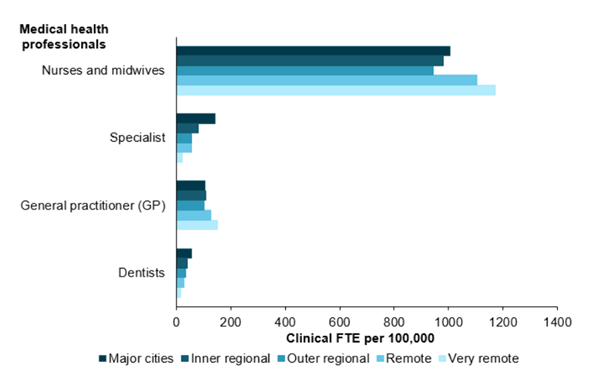
Graph: Employed health professionals
(Source: Segal, Marsh &Heyes, 2017)
From the above graph provided within this population assignment it can be observed that clinical nurses and midwives number increased in remote areas and very remote areas after the government initiative. The number of GP supply is also observed to increase in these areas.
Potentially preventable hospitalisations (PPH) are defined as preventive measures to reduce occurrence of the hospitalisation. PPH in remote areas increased with remoteness, however, with government initiatives this PPH rate in remote and very remote areas to some extent reduced. However, when compared with the major cities it can be observed that in between major cities and very remote areas PP is 2.5 times high, in remote areas it is 1.7 times high.
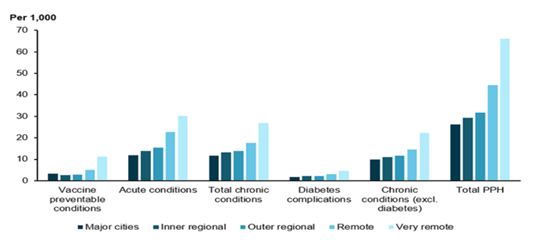
Graph : PPH rate
(Source: Veenendaal et al., 2018)
Conceptual Framework
From the above literature review build on this population assignment upon the heath care access in Australia it can be found that several studies have reached at several results regarding this aspect. Some studies have pointed out that access over heath care in Australia is due to inequality existing within the country, while other studies have shown that people living in rural areas due to certain factors like financial barrier do not opt for heath care services. Studies have also pointed out that lack of government evaluation of the programs have resulted in diminished access of heath care over course of time. Considering all these results from various studies a conceptual framework is extracted which is shown below within this population assignment.
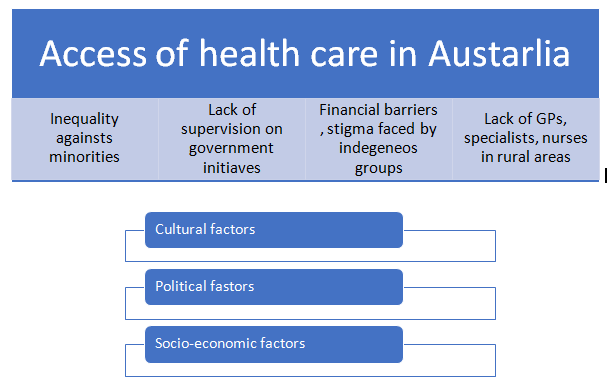
Diagram: Conceptual framework
(Source: Learners creation)
Methodology
This section of the proposal on population assignmentwill guide in understanding what methodology is elected by this study in order to reach at the optimal results.
Research method: Several kinds of research methods exists however, the method that will used utilised by this study is applied research method. This method is selected because it will help the researcher to solve the practical issues linked with the study. Applied research is a scientific method and its main purpose is generating empirical observations for solving critical problems in our society (Thorne, 2016). This method is expected to reach at solutions that can be originated to improve particular situations.
Research approach: Out of the three research approaches- Deductive, Inductive and Abductive, this study will use the deductive approach. This approach will help to create a link between the health care services and its delivery systems by the Australian government.
Research investigation: The main purpose of this research on population assignment is to examine the access of Australian population over the heath cares services and hence the main motive of this study is to create a link between satisfaction of the population in heath care services and the governmental delivery options. Hence, for the investigation purpose the most appropriate mode of investigation will be exploratory research mode.
Research instruments: In order to collect information regarding the satisfaction of the Australian population with the health care's services, this study will utilise both the qualitative and quantitative form. The collection method out of the two existing methods which are primary method and secondary method, this study will use the secondary method of data collection. Study will use several secondary sources to gather data and these sources will include articles, government websites, books, journal articles and many more. Thus, a thematic analysis will be carried out by the researcher within this population assignment to reach at the optimal results. A thematic analysis is one of the most appropriate and effective analysis that involves the entire standard tool for examining the qualitative data sets(Castleberry & Nolen, 2018). This analysis mainly focuses upon the identification aspects along with the feasible assessment from the diverse themes.
Data collected will be used in the form of table presentation, graph presentation and on the basis of these presentations concluding remarks will be undertaken. Hence it can be concluded that data analysis along with the thematic analysis will also involve observations and explanations process and this aspect is considered to arrive at optimal results.
Data sources: Studies on the topic and related to the selected topic of population assignment will be used as secondary sources. Published books, journal articles, government website will be the main sources of data collection procedure. Secondary sources will be considered either from readily available sources or from the university library site.
Research Project organisation, budget and schedule
Proposed Dissertation Structure
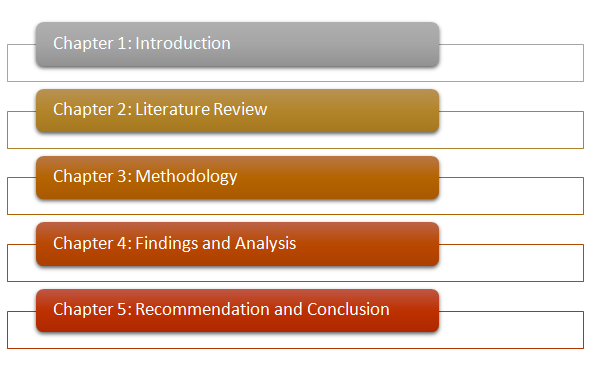
Figure 1: The Proposed Dissertation Structure
(Source: Created by the Learner)
This research study developed within this population assignment will involve five chapters in total and these chapters will show different aspects of the study. Chapter 1 will be upon the introduction of the study, this chapter will involve the basic foundation of the study along with the aims, objectives, question, scope and significance of the research. This second chapter will be upon the literature review and conceptual framework. This second chapter will involve a detailed analysis about the review of the different literatures which are conducted on the topic previously and based on this literature review, a conceptual framework will be reached. The third chapter of the study on population assignment will be upon methodology and the chapter will provide a thorough usage of research tools and techniques along with the description of them, this chapter thus will show the road map how researcher will reach the results of the study. Chapter 4 will involve the analysis part of the study along with the discussion part. Finally, chapter 5 will be the chapter upon conclusion and recommendations. This last chapter of population assignment will show the concluding results reached by the study and along with this this chapter will also provide some of the recommendations. Budget description
|
Research on the topic |
$25 AUD
|
|
Registration on library portal |
$30 AUD
|
|
Transport cost |
$20 AUD |
|
Preparation of documents |
$16 AUD
|
Table: Budget table
(Source: Leaners creation)
A total of $91 AUD will be required to prosecute this research study. The above table provided within this population assignment shows a detailing about the cost for different research aspects.
Project Schedule
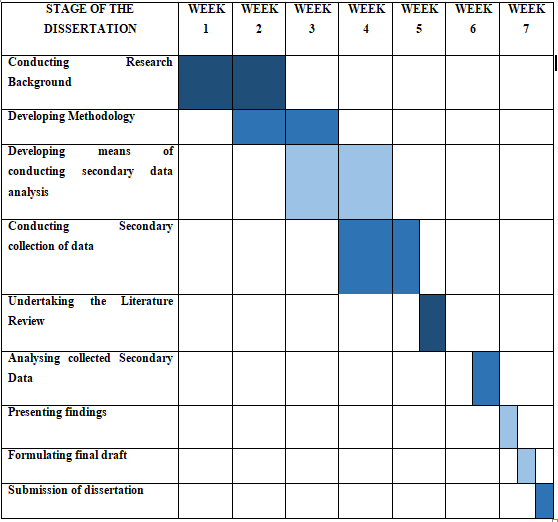
Reference
Altman, J. (2018). Alleviating poverty in remote Indigenous Australia: The role of the hybrid economy.
Castleberry, A., & Nolen, A. (2018). Thematic analysis of qualitative research data: Is it as easy as it sounds?.
Population assignmentCurrents in Pharmacy Teaching and Learning, 10(6), 807-815.
Cobiac, L. J., Tam, K., Veerman, L., & Blakely, T. (2017). Taxes and subsidies for improving diet and population health in Australia: a cost-effectiveness modelling study. PLoS medicine, 14(2).
Farrer, L. M., Walker, J., Harrison, C., &Banfield, M. (2018). Primary care access for mental illness in Australia: Patterns of access to general practice from 2006 to 2016. PloS one, 13(6).
Hopper, T., Lassou, P., &Soobaroyen, T. (2017).Globalisation, accounting and developing countries. Critical Perspectives on Accounting, 43, 125-148.
Jin, L., Kapadia, T. Y., Von Gehr, A., Rosas, E., Bird, J. B., Ramaswamy, D., & Patel, D. (2019).Feasibility of a preoperative anemia protocol in a large integrated health care system. The Permanente Journal, 23.
Jones, K., Keeler, N., Morris, C., Brennan, D., Roberts-Thompson, K., & Jamieson, L. (2016).Factors relating to access to dental care for Indigenous South Australians. Journal of health care for the poor and underserved, 27(1), 148-160.
Kwan, M. M., Kondalsamy-Chennakesavan, S., Ranmuthugala, G., Toombs, M. R., & Nicholson, G. C. (2017). The rural pipeline to longer-term rural practice: general practitioners and specialists. PLoS One, 12(7).
Mnatzaganian, G., Lee, C. M. Y., Robinson, S., Sitas, F., Chow, C. K., Woodward, M., & Huxley, R. R. (2020). Population assignmentSocioeconomic disparities in the management of coronary heart disease in 438 general practices in Australia.
European Journal of Preventive Cardiology, 2047487320912087.
Pandya, V., &Sisombat, S. (2017). Impacts of foreign direct investment on economic growth: Empirical evidence from Australian economy. International Journal of Economics and Finance, 9(5), 121-131.
Rasanathan, K., Bennett, S., Atkins, V., Beschel, R., Carrasquilla, G., Charles, J., ...& Kingsley, P. (2017). Governing multisectoral action for health in low-and middle-income countries. PLoS medicine, 14(4).
Segal, L., Marsh, C., &Heyes, R. (2017). The real cost of training health professionals in Australia: it costs as much to build a dietician workforce as a dental workforce. Journal of health services research & policy, 22(2), 91-98.
Senn, N., Cohidon, C., Breton, M., Levesque, J. F., &Zuchuat, J. C. (2019). Patterns of patient experience with primary care access in Australia, Canada, New Zealand and Switzerland: a comparative study. International Journal for Quality in Health Care, 31(9), G126-G132.
Steffens, M., Jamieson, L., &Kapellas, K. (2016). Historical factors, discrimination and oral health among Aboriginal Australians. Journal of health care for the poor and underserved, 27(1), 30-45.
Thorne, S. (2016). Interpretive description: Qualitative research for applied practice. Population assignmentRoutledge.
Trankle, S. A., &Reath, J. (2019). Partners in Recovery: an early phase evaluation of an Australian mental health initiative using program logic and thematic analysis. BMC health services research, 19(1), 524.
Tse, T., Carey, L., Cadilhac, D., Koh, G. C. H., & Baum, C. (2016).Application of the World Stroke Organization health system indicators and performance in Australia, Singapore, and the USA. International Journal of Stroke, 11(8), 852-859.
Tynan, A., Walker, D., Tucker, T., Fisher, B., & Fisher, T. (2020). Factors influencing the perceived importance of oral health within a rural Aboriginal and Torres Strait Islander community in Australia. BMC public health, 20, 1-9.
Veenendaal, B., Koh, C., Saleem, A., Varhol, R., Xiao, J., Mai, B., & Liu, Y. (2018).EXPLORING GEOSPATIAL VARIATION IN DIABETES-RELATED PRIMARY HEALTH CARE SERVICE UTILISATION AND POTENTIALLY PREVENTABLE HOSPITALISATIONS IN WESTERN AUSTRALIA. International Archives of the Photogrammetry, Remote Sensing & Spatial Information Sciences, 42(4).
Worrall-Carter, L., Daws, K., Rahman, M. A., MacLean, S., Rowley, K., Andrews, S., ...&Arabena, K. (2016). Exploring Aboriginal patients’ experiences of cardiac care at a major metropolitan hospital in Melbourne. Population assignmentAustralian Health Review, 40(6), 696-704.












